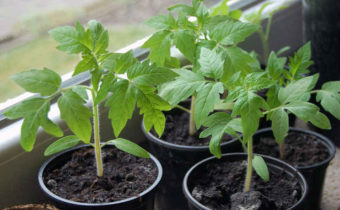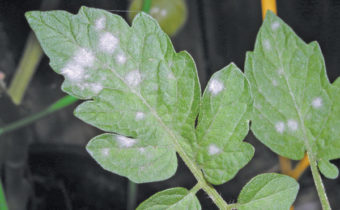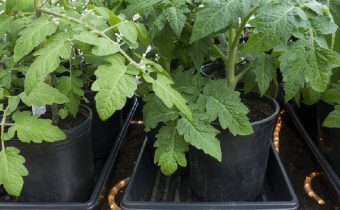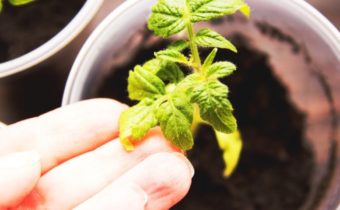Root rot (black leg) on tomatoes, what to do?
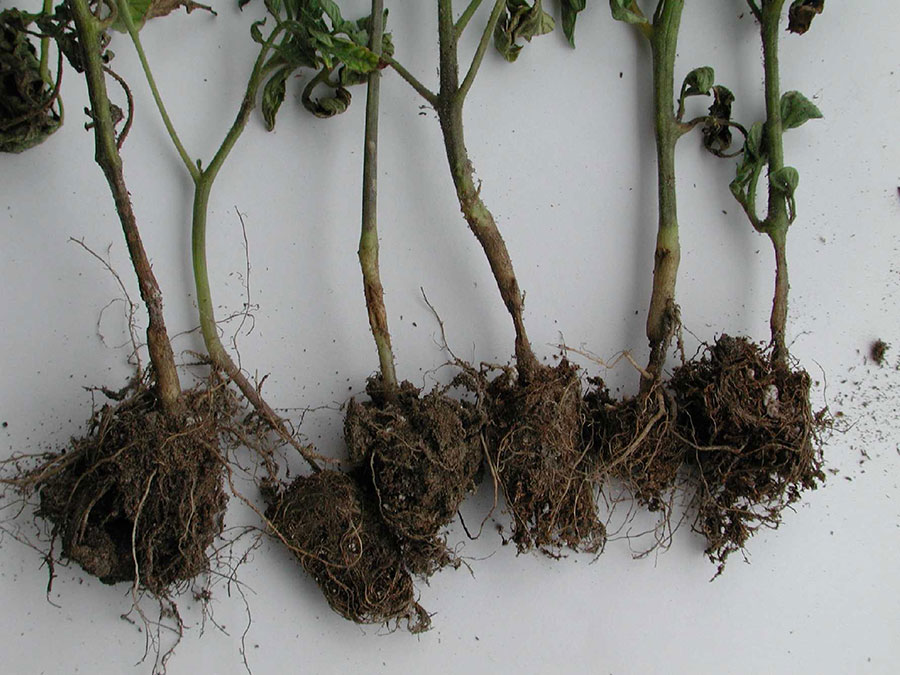
In young tomato seedlings, the root system may rot, and the root neck of the plant is affected. This is due to infection of the plant with an infectious disease called root rot or blackleg. Diseased tomatoes eventually die, and this has a noticeable effect on the future crop of tomatoes.
Disease description
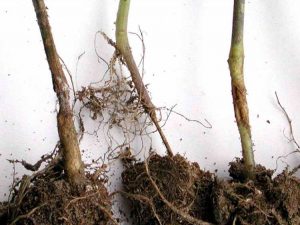
Black foot is most often marked on tomato seedlings or on still very young plants. Olpidium or Pythium fungi excite the disease, the spores of which are always in the upper layers of the soil. As food, the fungus is, as usual, the tissue of dead plant organisms. However, if the soil moisture is too high, and the air temperature is higher than the recommended values, the fungus can spill over and start affecting the live roots and basal neck of tomatoes.
Having penetrated into the roots of a tomato, the mycelium goes on to feed on the plant sap, grows wide and deep, affecting the entire lower part of the seedling.
A similar disease is noted on many cultivated plants, but most often the fungus parasitizes on seedlings of the following cultures:
- tomatoes;
- pepper;
- decorative flowers;
- cabbage;
- cucumbers.
Infection occurs only when suitable conditions arise, including high soil and air humidity, high acidity of the soil solution, and the presence of weakened seedlings.
Causes of
Spores of a pathogenic fungus are capable of staying in the soil for a long time without any harmful effects and can enter an active phase when conditions for their development arise.
Scientific research and many years of practical experience have revealed the following causes of seedling disease of the black leg:
- if the acidity of the soil solution is above the norm;
- when soil moisture reaches 85-90% or more;
- when seedlings are grown at lower or higher temperatures than recommended;
- with a large difference between day and night temperatures, as well as when drastic changes in climate occur;
- neglect of irrigation regime;
- high sowing density;
- violations of the seedlings picking technology were committed;
- use of infected substrate for seeding;
- the use of seeds of poor quality;
- selection of root-rot-resistant varieties;
- lack of light for seedlings;
- the presence of drafts in the room where they grow seedlings.
It is very difficult to treat root rot, it is impossible to save the diseased plants. It is much easier, by conducting a series of preventive measures, to prevent disease.
Signs of
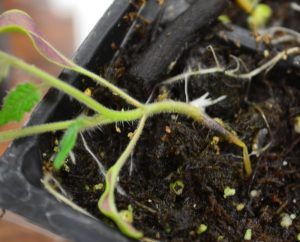
Starting signs of infection of tomatoes appear before the leafing on the seedlings. At the bottom of the stem - in the area of the root collar a slight darkening occurs, and then blackness of the entire lower part of the seedling occurs.
Young plants stop growing, their leaves curl and dry. Weakened and deprived of immunity seedlings die a few days after infection.
The insatiable fungus uses water and beneficial elements from the soil for its nutrition. Seedlings fall on the soil, where their decomposition continues. As a result, the stem of the plant turns into a thin black thread.
Methods of struggle
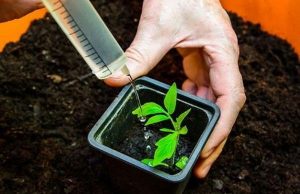
Treatment of root rot gives some result only at the start of the development of the disease. The fungus grows so rapidly on the seedlings that it is rarely possible to save it. Affected plants are easier to remove from crops than to heal, because, after curing, they will lag behind in development and the crop will be poor.
Hardly having found root rot, you need to resort to the following measures:
- For a while, stop watering the seedlings, and also remove all diseased and weakened seedlings. If the planting density is too large, it should be reduced by thinning the plants.
- The primer should be sanitized. To do this, the soil is loosened, and then use a 1% solution of the following drugs:
- Bordeaux fluid;
- potassium permanganate;
- copper sulphate;
- formalin.
If the soil soil is characterized by high acidity, it is necessary to add one of the three components to it:
- ground coal (0.5 kg per 1 m2);
- wood ash;
- lime (0.2-0.4 kg per 1 m2).
Fungicide use
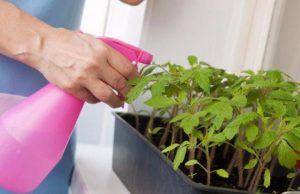
If time is lost, and the seedlings are already affected by the black leg, you should contact one of the fungicides. For an effective fight with a black leg such means are suitable:
- Ridomil Gold;
- Tiovit Jet;
- "Colloidal sulfur";
- "Fundazol".
Applying one of these drugs and strictly adhering to the instructions for use, you can beat this insidious tomato disease, like root rot.
The use of biologics
The aboveground part of the seedlings can be treated with biological products. For this most often used:
- Fitosporin-M (5 g per 10 l of water);
- "Fitolavin" (20 ml per 10 l of water)
- "Trichodermin" (100-150 ml per 4 liters of water).
Treatment of diseased plants with biological products can be repeated every 10 days, until the seedlings are completely cured.
Folk methods
You can fight the root rot of seedlings not only through chemical and biological preparations, but also with the help of folk remedies. They have poor efficacy, but in combination with other drugs, can be used as additional measures.
Of these home remedies include the following:
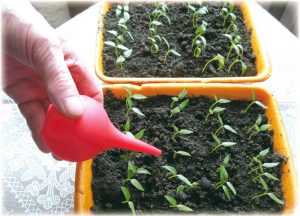
- Iodine solution. To do this, dilute the alcohol solution with water in a ratio of 1: 4. The resulting composition moisten the upper roots and the lower tier of the stem of tomato seedlings.
- A solution of potassium permanganate. To do this, prepare a weak solution of potassium permanganate on water, which moisten the soil and treat the root neck of tomatoes.
- Chalk and ash. To do this, take both ingredients in equal parts, crush them, and then powder the lower part of the stem and the roots located in the upper level of the soil.
- Vodka. Separate gardeners are struggling with black leg, using ordinary vodka. The treatment of plants with this popular product is carried out by spraying the vegetative part of the plants, previously diluting it with water in a ratio of 1:10.
- Onion infusion. Much more often vodka, for spraying tomato seedlings from root rot, apply an infusion of onion peel. This composition is allowed to process infected plants 2 times a week.
All tools used: shovels, hoes, knives, pruners, it is necessary to wash more often and from time to time to expose the disinfection fungicidal agents. Many pathogens are spread by non-sterile instrument.
Prevention
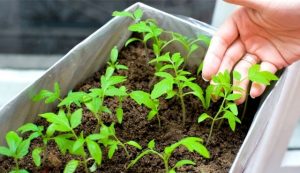
Activities carried out on the seedlings of tomatoes, minimize the risk of infection with a black leg and eliminate the need to carry out treatment.
The complex of preventive measures should include the following actions:
- To prevent the formation of moisture in the area of the root collar, fresh sand should be regularly sprinkled on the ground.
- Under control should be the acidity of the soil, should not be applied substrates with high acidity.
- Strictly adhere to the watering mode. After irrigation, the soil surface should dry well. The occurrence of stagnant water is completely unacceptable.The temperature of irrigation water should be within 21-24 degrees.
- If you use plastic film for the cultivation of seedlings, be sure to ventilate the room.
- To ensure the respiration of the roots, you should use peat pots or plastic cups with perforation.
- Be attentive to seed selection. They should be purchased only in specialized stores. When buying, it is necessary to give preference to varieties resistant to the complex of infectious diseases.
- Even before sowing, seeds and soil need to be disinfected. It is extremely undesirable, when preparing the soil for growing seedlings of tomatoes, to use manure, because it can live pathogens.
The disease is progressing rapidly also because the seedlings do not have immunity and are not able to resist infection. To prevent the disease, it is necessary not only to carry out preventive measures, but also to apply fertilizers as well as growth stimulants.
Resistant varieties
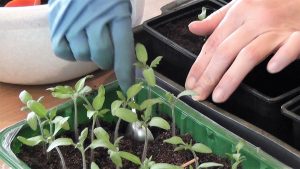
It is possible to counteract the possible defeat of tomatoes with a black leg by growing varieties that are resistant to this disease. The following are varieties and hybridswith such stability:
- "Spartak F1;
- "Virtuoso F1";
- "Blitz";
- "Bohemia";
- "Little Prince";
- "Moscow Lights";
- Orange Giant;
- “The Pickling Miracle”;
- "Profitable";
- "Ray";
- "Ural".
Black leg on tomato seedlings is the most dangerous disease of this culture. The affected plants are not always able to be saved, and the surviving seedlings will not give the expected yield. Therefore, the focus, when growing tomato seedlings, should be given to preventive measures. Only in this case it will be possible to grow healthy seedlings and get a good result.


